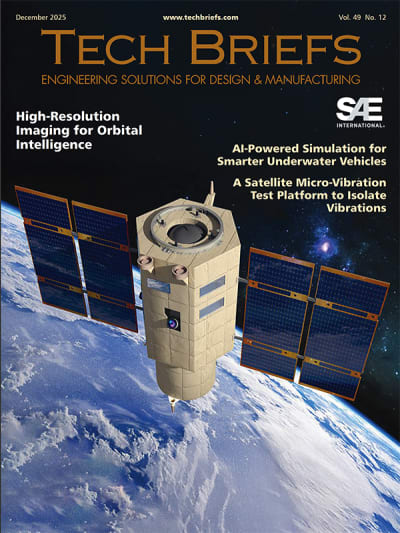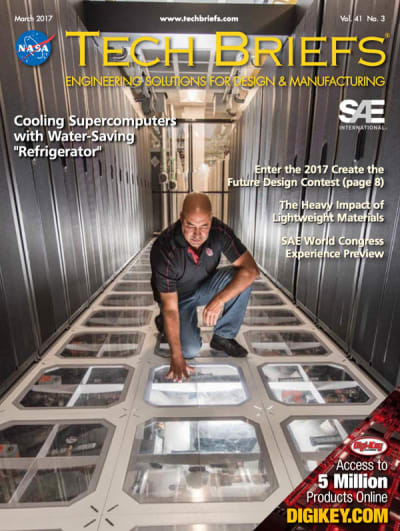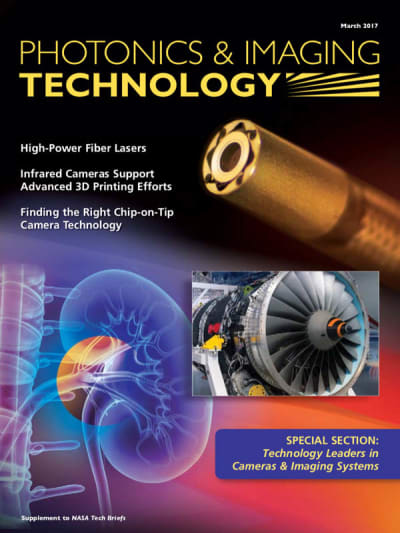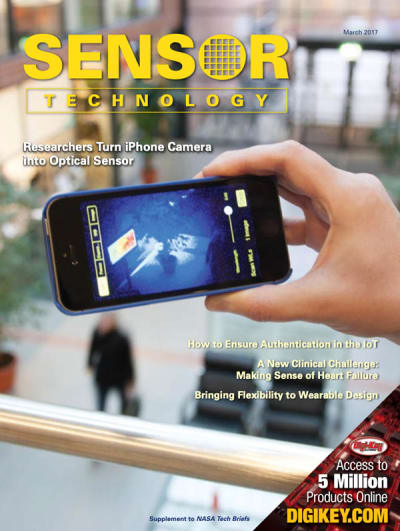Inside this issue
Overview
The March 2017 edition of NASA Tech Briefs and Sensor Technology presents a wealth of innovative research and technological advancements across various fields. This issue highlights significant developments in the Internet of Things (IoT), wearable technology, optical sensors, supercomputing, and lightweight materials, making it a valuable resource for engineers, researchers, and technology enthusiasts.
Key Features and Articles:
-
How to Ensure Authentication in the IoT: As the IoT continues to expand, ensuring secure authentication is paramount. This article discusses the challenges associated with IoT security and presents strategies to enhance authentication processes. It emphasizes the need for robust security measures to protect sensitive data and maintain user trust in connected devices.
-
A New Clinical Challenge: Making Sense of Heart Failure: This piece addresses the growing concern of heart failure, a condition affecting millions worldwide. It explores innovative approaches to diagnosis and treatment, including the use of advanced sensors and data analytics to monitor patients' health in real-time. The integration of technology in healthcare is highlighted as a means to improve patient outcomes and streamline clinical workflows.
-
Bringing Flexibility to Wearable Design: Wearable technology is rapidly evolving, and this article showcases the latest trends in flexible design. It discusses how new materials and manufacturing techniques are enabling the creation of more comfortable and functional wearable devices. The focus is on enhancing user experience while maintaining performance, which is crucial for the adoption of wearable technology in everyday life.
Researchers Turn iPhone Camera into Optical Sensor: A groundbreaking development is presented where researchers have successfully transformed an iPhone camera into a sophisticated optical sensor. This innovation opens up new possibilities for mobile diagnostics and environmental monitoring, allowing users to conduct complex analyses using a device they already own. The implications for accessibility and convenience in scientific research are significant.
-
Cooling Supercomputers with Water-Saving "Refrigerator": As supercomputers become increasingly powerful, the need for efficient cooling solutions is critical. This article introduces a novel water-saving refrigeration system designed to cool supercomputers effectively. The technology not only reduces water consumption but also enhances the overall efficiency of data centers, addressing environmental concerns associated with traditional cooling methods.
-
The Heavy Impact of Lightweight Materials: The use of lightweight materials is transforming various industries, particularly aerospace and automotive. This article examines the benefits of incorporating these materials into design and manufacturing processes, including improved fuel efficiency and reduced emissions. It also discusses the challenges of material selection and the importance of balancing performance with weight reduction.
-
2017 Create the Future Design Contest: This issue encourages readers to participate in the 2017 Create the Future Design Contest, which invites innovative ideas and solutions across multiple categories. The contest aims to inspire creativity and foster technological advancements that can address real-world challenges. Participants have the opportunity to showcase their designs and potentially gain recognition in the engineering community.
Editorial Insights: The editorial team, led by Joseph T. Pramberger and Linda L. Bell, emphasizes the importance of innovation in driving progress across various sectors. The issue serves as a platform for sharing knowledge and fostering collaboration among engineers, researchers, and industry professionals.
Navigation and Accessibility: The digital edition is designed for easy navigation, featuring a user-friendly interface that allows readers to quickly access articles, zoom in on content, and search for specific topics. This enhances the reading experience and ensures that valuable information is readily available.
Conclusion: The March 2017 edition of NASA Tech Briefs and Sensor Technology is a comprehensive resource that showcases the latest advancements in technology and engineering. With a focus on practical applications and innovative solutions, this issue provides insights that are relevant to a wide audience, from industry professionals to academic researchers. The articles not only highlight current trends but also inspire future developments that can shape the technological landscape. As we continue to explore the intersection of technology and society, this edition serves as a reminder of the potential for innovation to address pressing challenges and improve quality of life.
Features
Tech Briefs
-
Manufacturing & Prototyping
Hot Isostatic Pressing of 60-Nitinol
Logistics for Building Radiation Storm Shelters and their Operational Evaluation
Vapor-Barrier Vacuum Isolation System
Silicon Micro-Emitters for Microfluidic Electrospray Propulsion Systems
-
Software
BPTables DTN Bundle Filtering Framework
-
Mechanics & Machinery
Development of the Orion Crew-Service Module Umbilical Retention and Release Mechanism
Micro-Lid for Sealing a Sample Reservoir for Micro-Extraction Systems
Single-Fluid-Pumped Radiators with Increased Turn-Down Ratio and Control in the Stagnation Regime
-
Electronics & Computers
MRAM Alternative Uses Less Energy than Conventional Chip
Reconfigurable Chaos-Based Microchips
Supercomputer Cooling System Uses Refrigerant to Replace Water
Computer Chips Calculate and Store in an Integrated Unit
Printed Circuit Board Design Software Helps Create New Energy Solutions
Electron-to-Photon Communication for Quantum Computing
Material Combination Enables Transistor Gate Length of 1 Nanometer
-
Aerospace
Nodal Averaging Program for CFD Planes
Transformable and Reconfigurable Entry, Descent, and Landing Systems and Methods
High Speed Idle Engine Control Mode
Blended Cutout Flap for the Reduction of Jet-Flap Interaction Noise
Method and System for Air Traffic Rerouting for Airspace Constraint Resolution
Hybrid Flow Control Method for Simple Hinged Flap High-Lift System
-
Energy
High-Voltage Supercapacitors for Improved Energy Density Hybrid Power Sources
Products
-
Briefs
2.2-Micron, Uncooled, InGaAs Photodiodes and Balanced Photoreceivers up to 25-GHz Bandwidth
Fourier Transform Spectrometer System
Large-Area, Polarization-Sensitive Bolometer for Multi-Mode Optics
-
Applications
-
Technology Leaders
Finding the Right Chip-on-Tip Camera Technology
-
Products
-
Briefs
Piezoelectric Field Disturbance Sensing System and Method
Intelligent Displacement Sensor Deployment Using MTConnect Protocol over Ethernet
-
Articles
CERTIFICATES AND SIGNATURES: How to Ensure Authentication in the IoT
Researchers Turn iPhone Camera into Optical Sensor
SOLVING THE INTERCONNECT CHALLENGE: How to Bring Flexibility to Wearable Design
-
Products




